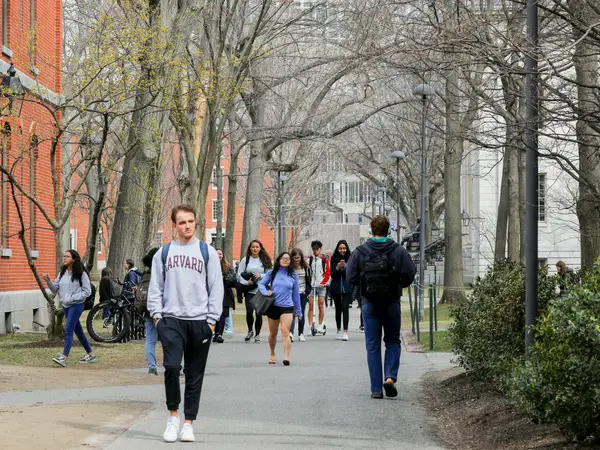The ever-increasing cost of college tuition in the United States puts financial pressure on those who want to pursue a bachelor's degree.
Knowing that college would cost a fortune, Rachel Edington, a freshman psychology major at the University of Texas, started saving early. She applied for multiple scholarships, lived with four other people in an apartment a half-hour from campus, took extra college credits from high school, and worked 40 hours a week.
But even with family aid, savings and her current income, Rachel is still not enough. She is among millions of students across the country struggling with skyrocketing tuition costs.
Data from the university ranking organization USNews shows that from 2003 to 2023, tuition at public universities in the US increased by 141% for international students and 175% for domestic students. At private universities, tuition increased by 134%. And in 20 years (2000-2020), the total cost of university tuition and fees increased by 67%, more than double the increase in the consumer price index (33%), according to Best Colleges.
In 2022 alone, the average tuition at private universities in the US increased by about 4% compared to the previous year, to nearly $40,000 per year. The average tuition at public universities increased by 0.8%, to about $10,500.
In addition to tuition, students also have to pay for food, housing, and transportation. For example, this year, Harvard students pay $57,000 in tuition and fees. When housing, food, books, and other living expenses are added, the total bill rises to $95,000.
College in the US is getting more expensive for many reasons.
Universities spend a lot of money hiring professors, said Catharine Hill, an education nonprofit at Ithaka S&R. Many industries can offset the costs by using AI and robotics to increase productivity, but not in higher education . Faculty productivity has not increased enough to keep costs down.
States are also spending less on public education than they used to. According to the National Education Association, 37 states saw their funding for higher education decline by an average of 6% in 2021 compared to 2020. This has forced schools to rely more on tuition.
College costs are also driven up by investments in luxury services, unrelated to teaching, to attract students. According to ACTA, a non-profit organization for higher education, college spending on luxury dormitories, dining halls, gyms, etc. increased by 29% from 2010 to 2018. Meanwhile, spending on faculty increased by only 17%.
Rising tuition costs are forcing many students into debt. But universities know that if they raise tuition, the government will increase student loan limits. So they have no incentive to do the opposite.
Additionally, because a bachelor’s degree often comes with a lot of benefits, many people will continue to take on debt to attend college. A 2021 Georgetown University study found that high school graduates earn about $1.2 million less over their lifetime than those with a bachelor’s degree.

Harvard University campus. Photo: Harvard University
Rising tuition costs have created a student debt crisis. Over the past 15 years, total student loan debt in the United States has tripled, from about $580 billion in 2008 to $1.76 trillion. Forty-three million Americans owe money for college, including 55 percent of students at public universities. Many continue to carry debt through college and into retirement. Data from the Federal Student Aid Administration shows that 2.4 million borrowers age 62 and older owe a combined $98 billion.
For many young people, it is a struggle to pay for college. Working part-time is a popular option, but the financial pressure can also affect their health and studies.
"I work two jobs, have scholarships, I have loans, but I'm still stressed about money," said Madison Fanus, a sophomore at Dickinson College.
And Edington, after consistently working 40 hours a week, was diagnosed with an autoimmune disease brought on by stress. "Working almost full-time while going to school was overwhelming," Edington said, eventually taking out loans to make up for lost sick leave.
According to a survey conducted by the American Association for Continuing and Higher Education in early 2022, financial stress accounts for 42% of the reasons why students drop out of school. Finances and student debt are also among the top five factors that stress students (32%), according to a survey by TimelyCare, a company specializing in student health services.
Jennifer Finetti, director of Scholarship Owl, a US-based scholarship management and networking company, said that on average, a student spends about 20 years paying off their college loans. After graduating, they have to delay buying a car, a house or saving for their children because of these debts.
Rising tuition costs and mounting debt have also contributed to Americans losing faith in the value of a college degree. According to The Wall Street Journal, the number of Americans who believe a college degree is important for future job prospects has dropped from 53% in 2013 to 42% this year. The number of high school graduates who go straight to college has also dropped from 70% in 2016 to 62%.
For international students, rising tuition costs make pursuing the American dream even more difficult. International students already pay tuition that is double or triple that of U.S. students. Most of them are not eligible for financial aid from the federal government or their schools like domestic students. They also cannot take out student loans unless they find a U.S. citizen or legal permanent resident to co-sign the loan.
The money earned from part-time jobs rarely makes up for the financial shortfall, because under US law, they are only allowed to work a maximum of 20 hours per week during the first year of study, and only on campus.
"The rising cost of college has put a lot of stress on my family. I'm not sure if I can continue my studies," said a Turkish student at the University of San Diego, California.
To solve this, Ankers says, there needs to be more pathways, such as apprenticeships, to get students into good jobs outside of college. She predicts that many employers will drop the requirement for a degree. Bryan Caplan of George Mason University also believes that the average high school student should only go to college if they are ready to pursue fields like business or engineering.
Janet Napolitano, of the University of California at Berkeley, believes that the way to reduce costs is to reduce the time it takes to earn a degree. She says states should encourage students to attend community colleges, which are cheaper, while still in high school. They can then transfer their credits to a university and graduate early.
Jennifer Finetti advises students to apply for scholarships every week throughout the year.
“It sounds difficult, but the success rate is very high if you really try,” she said.
Khanh Linh (According to USNews, Usatoday, CNN, SBS)
Source link


































































































Comment (0)